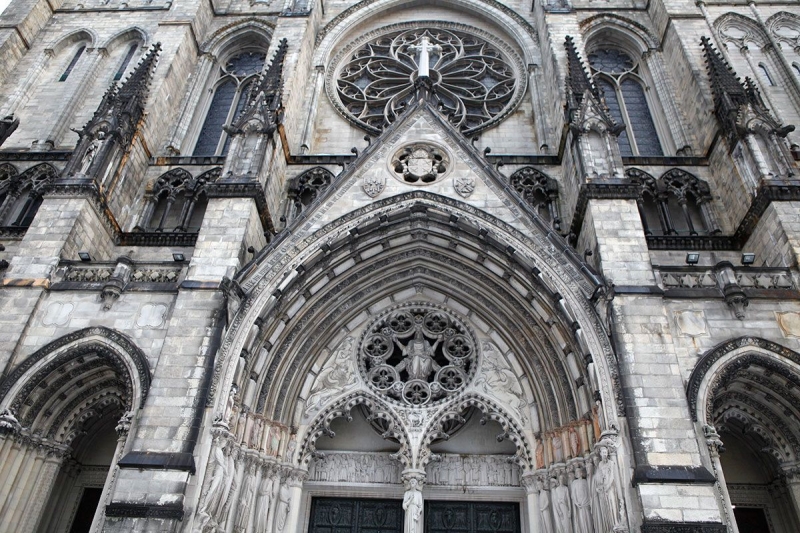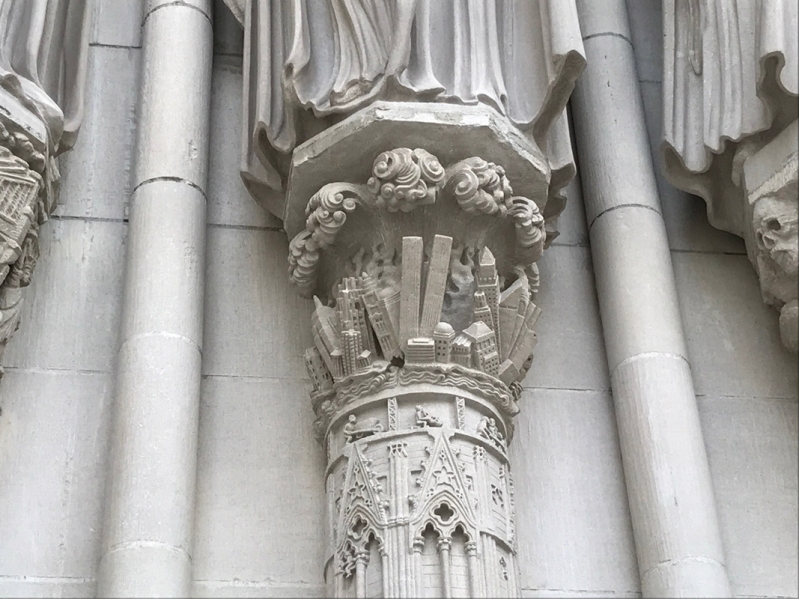Explore The Cathedral
The Cathedral is an active house of worship and vibrant community, arts and cultural, and civic center, as well as a feat of human engineering. Click the numbers on the map below to learn more about the history, features, and symbolism in the Cathedral.
Cathedral Architecture

In a city of skyscrapers, the Cathedral impresses with sheer size. Its detailed façade towers over Amsterdam Avenue, and the building extends a full avenue block to Morningside Drive. The Cathedral is more than 120 years old, and remains unfinished. Despite incomplete construction, it is the largest cathedral in the world, making it a global landmark. The Cathedral’s distinctive architecture is an equal claim to fame, and an important monument in the history of its neighborhood and city.
The Cathedral was constructed in roughly three phases, proceeding from east to west.
First Phase: Heins & LaFarge
The initial architects of the Cathedral, George Lewis Heins and Christopher Grant LaFarge, envisioned a Romanesque-Byzantine style structure, visible today in the Crossing, Apse, and chapels. The seven apsidal chapels were a winning element of their design: in a nod to the turning tides of American immigration at the turn of the century, each chapel was built in a different national style and named for saints of different national origins. The chapels are also arranged geographically, with the Spanish-inflected Chapel of Saint James on the south side, proceeding through Italian, French, Eastern Mediterranean, British, and German chapels to the Scandinavian style Chapel of Saint Ansgar on the north side.
Other key Romanesque features of Heins & LaFarge’s design are the solid granite columns, which surround the High Altar, as well as the tiled barrel-vault ceilings. The Cathedral’s crossing, where Sunday services are typically held, provides an excellent view of the titanic granite arches that support the building, which elsewhere are covered by a layer of decorative limestone. The dome over the crossing, which could fit the Statue of Liberty underneath, is made of Guastavino tile, and was installed as a temporary covering. The dome was meant to be removed when the transepts (north and south aisles) of the Cathedral were built, but as yet only half of the north transept is constructed.
Second Phase: Ralph Adams Cram
The Nave of the Cathedral is a triumph of neo-Gothic or Gothic Revival architecture, the favorite of its designer, Ralph Adams Cram. Gothic architecture began in France and flourished throughout Europe in the 12th to 16th centuries. It experienced a revival in the late 19th century, in Britain and then in the United States, and Cram seized upon this new popularity in his design. The Nave shows the characteristic ribbed vaulting and pointed arches of Gothic architecture, as well as flying buttresses and the sublime stained glass windows. Like the Crossing, the Nave has a granite substructure, which above ground is faced with limestone.
Cram insisted on adhering closely to the tradition of Gothic buildings. For this reason, the Cathedral has no steel or iron skeleton, and the stained glass windows are “true” stained glass, or pot-glass, made of sand and metal ash, which has been shaped and assembled according to medieval techniques. The window imagery is deliberately medieval in style and composition, but the figures are the contemporaries of art deco, modern, and even postmodern art. (Most of the windows were designed in the 1920s, but fabrication and installation lasted into the 1950s.)
The Great Rose Window holds pride of place on the western wall of the Cathedral. At forty feet in diameter, it is the third largest rose window in the world and is made of over ten thousand pieces of glass. At its center is Jesus, surrounded by New and Old Testament prophets, as well as sixteen angels. Below it is the Lesser Rose Window, shaped like a seven-pointed star. At its center is the Christogram (iota-eta-sigma).
The full length of the Cathedral—at a record-breaking 601 feet—was completed and consecrated on November 30, 1941. One week later, the attack by the Japanese at Pearl Harbor brought the United States into World War II. The subsequent economic and human mobilization brought construction to a sudden halt.
Third Phase: Bell Towers and Restoration
The newest parts of the Cathedral include the south bell tower and the carvings around its center portal. These were constructed by stonemasons trained in the Cathedral’s own Stoneyard, which opened in 1979 to teach and employ neighborhood residents. Due to a lack of American master stonemasons, the Stoneyard apprentices were taught by English masons.
The bell tower rose according to Cram’s design beginning in 1982, but funds petered out by the early 1990s. As a result, the tower cuts off “in mid-sentence,” at about two-thirds of its intended height. The newer stone makes a strong contrast with the more weather worn parts of the West Front.
The Portal of Paradise, as the Cathedral’s central portal is called, was completed by master stonecarver Simon Verity between 1988 and 1997. The figures of the Portal reflect a modern sensibility in their proportions and features. At the same time, the smaller three-foot figures have been painted (polychromed), a practice for decorating sculpture that goes back to ancient Greece. The frieze over the Portal doors shows Jesus, and below him is John the Divine with paper and quill. Flanking the doors are Old and New Testament figures. Under their feet are some of the most striking examples of the Cathedral’s modern stonework. In keeping with the Italian Renaissance tradition of depicting biblical scenes in modern settings, the sections below these figures show visions of destruction, with NYC skyscrapers collapsing beneath the mushroom cloud of a nuclear explosion. But beneath these scenes is another: that of resurrection, as stonemasons build a great cathedral upon the ashes of the city, just as Nehmiah built the Second Temple upon the ruins of Solomon’s temple.
In keeping with medieval tradition, the Portal of Paradise figures are based on a variety of models, including neighborhood business owners and Verity’s own friends.
In December 2001, a fire destroyed the Cathedral’s gift shop, located in the partially constructed North Transept, and filled the Nave with smoke. The Cathedral was closed in sections between 2004 and 2008, for a complete cleaning and restoration of the interior. Several of the arches crossing the nave retain their darkened color from before the fire.
Cathedral Symbolism

The Cathedral draws on strong architectural traditions and symbolism, which were intended, whether one thousand or one hundred years ago, to affect a visitor’s experience. Many of these can be “read” in its architecture, enriching the experience of the building.
The Building
The Cathedral follows several major medieval traditions: it is built on high ground—Morningside Heights is at one of the highest natural elevations in New York City—and its ground footprint is (in design, at least) shaped like a Roman cross. The entrance stairs provide further uplift toward the heavenly plane, and more stairs within the Cathedral elevate the Great Choir and chapels, and above them the High Altar. This holiest part of the church is traditionally found in the eastern end of the building, closest to the rising sun, a symbol of renewal and resurrection.
The Nave
The Nave follows a similar vertical convention. Each vertical set of stained glass windows is dedicated to one of fourteen forms of human endeavor, including Labor, Medicine, Education, Military, Arts, and Sports. On the ground level, the windows show a variety of historical and scriptural figures engaged in a particular activity—the Medical bay, for example, shows Jesus performing healing miracles as well as Louis Pasteur inoculating a sheep. The higher set of windows show saints associated with the same activity and a rosette window at the top depicts Jesus. He appears in many variations, crowning each window and completing the progression from the human plane to the sacred and divine.
From west to east run three aisles of bronze floor medallions, collectively referred to as the Pilgrims' Pavement. The side aisle medallions show the names and crests of key pilgrimage sites, as well as significant sites in Anglican history, while the central aisle marks the miracles performed by Jesus, from birth through the Feeding of the Multitude at Bethsaida. The pavement should end with the Resurrection, but is truncated by the unfinished floor of the crossing.
Saint John the Divine
References to Saint John the Divine, the Cathedral’s namesake, are infused into the building. John is credited as the author of the Book of Revelation, relating his vision of the end of the world. The number seven is the most prominent symbol in Revelation, and structures the text itself. Sevens are therefore abundant in the Cathedral: in its seven chapels, north and south side bays, and in its dimensions.
John’s symbol, the seven stars or candles, is echoed in the seven lamps above the High Altar. The colors of the paving stones in the Apse and Great Choir echo the precious stones named in Revelation as those adorning the walls of the New Jerusalem. Visitors will find many more examples of this “sacred geometry,” with its symbolic numbers and shapes, throughout the building.
The Cathedral’s symbolism spans from the building as a whole to the smallest corner of its windows. Designed to create a sense of uplift, awe, and human connection, architecture does its part in the Cathedral mission to be “a house of prayer for all people and a unifying center of intellectual light and leadership.”